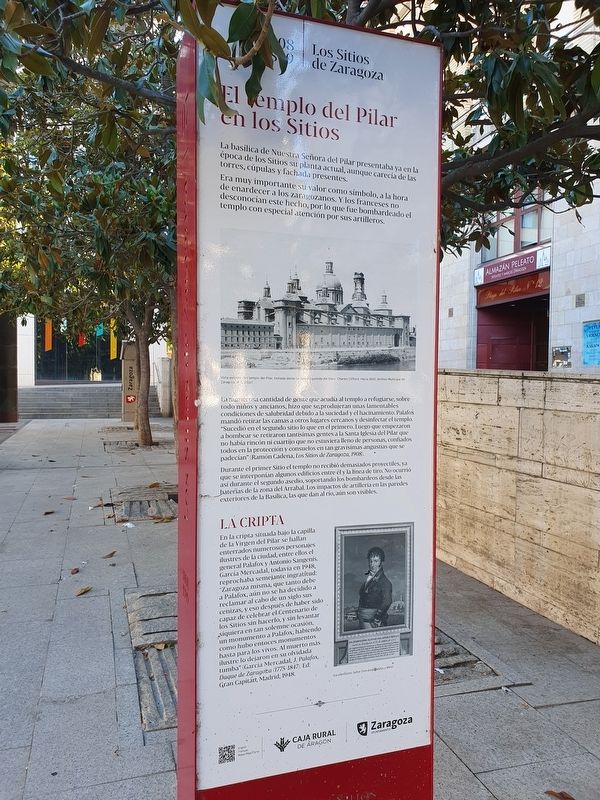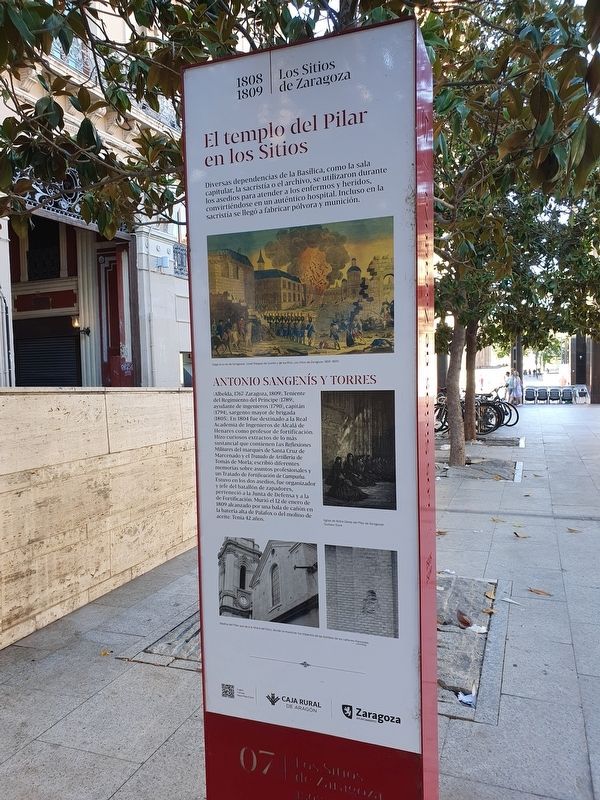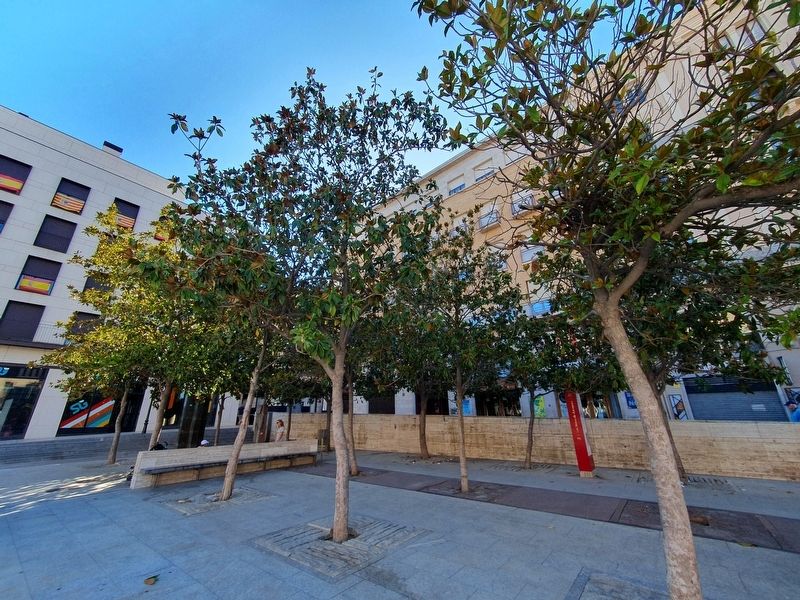Casco Antiguo in Zaragoza, Aragón, Spain — Southwestern Europe (Iberian Peninsula)
El Pilar Cathedral in the Sieges
1808 · 1809 Los Sitios de Zaragoza
La basílica de Nuestra Señora del Pilar presentaba ya en la época de los Sitios su planta actual, aunque carecía de las torres, cúpulas y fachada presentes.
Era muy importante su valor como símbolo, a la hora de enardecer a los zaragozanos. Y los franceses no desconocían este hecho, por lo que fue bombardeado el templo con especial atención por sus artilleros.
La numerosa cantidad de gente que acudía al templo a refugiarse, sobre todo niños y ancianos, hizo que se produjeran unas lamentables condiciones de salubridad debido a la suciedad y el hacinamiento. Palafox mandó retirar las camas a otros lugares cercanos y desinfectar el templo. “Sucedió en el segundo sitio lo que en el primero. Luego que empezaron a bombear se retiraron tantísimas gentes a la Santa Iglesia del Pilar que no había rincón ni cuartijo que no estuviera lleno de personas, confiados todos en la protección y consuelos en tan gravísimas angustias que se padecían” (Ramón Cadena, Los Sitios de Zaragoza, 1908).
Durante el primer Sitio el templo no recibió demasiados proyectiles, ya que se interponían algunos edificios entre él y la línea de tiro. No ocurrió así durante el segundo asedio, soportando los bombardeos desde las baterías de la zona del Arrabal. Los impactos de artillería en las paredes exteriores de la Basílica, las que dan al río, aún son visibles.
La Cripta
En la cripta situada bajo la capilla de la Virgen del Pilar se hallan enterrados numerosos personajes ilustres de la ciudad, entre ellos el general Palafox y Antonio Sangenís. García Mercadal, todavía en 1948, reprochaba semejante ingratitud: “Zaragoza misma, que tanto debe a Palafox, aún no se ha decidido a reclamar al cabo de un siglo sus cenizas, y eso después de haber sido capaz de celebrar el Centenario de los Sitios sin hacerlo, y sin levanter siquiera en tan solemne ocasión, un monumento a Palafox, habiendo como hubo entoces monumentos hasta para los vivos. Al muerto más ilustre lo dejaron en su olvidada tumba” (Garcia Mercadal, J. Palafox, Duque de Zaragoza (1775-1847). Ed. Gran Capitán, Madrid, 1948.
El Templo del Pilar en los Sitios
Diversas dependencias de la Basílica, como la sala capitular, la sacristía o el archivo, se utilizaron durante los asedios para atender a los enfermos y heridos, convirtiéndose en un auténtico hospital. Incluso en la sacristía se llegó a fabricar pólvora y munición.
Antonio Sangenís y Torres
(Albelda, 1767-Zaragoza,
1809). Teniente del Regimiento del Príncipe (1789), ayudante de ingenieros (1790), capitán (1794), sargento mayor de brigade (1805). En 1804 fue destinado a la Real Academia de Ingenieros de Alcalá de Henares como profesor de fortificación. Hizo curiosos extractos de lo más sustancial que contienen Las Reflexiones Militares del marqués de Santa Cruz de Marcenado y el Tratado de Artillería de Tomás de Morla; escribió diferentes memorias sobre asuntos profesionales y un Tratado de Fortificación de Campaña. Estuvo en los dos asedios, fue organizador y jefe del batallón de zapadores, perteneció a la Junta de Defensa y a la de Fortificación. Murió el 12 de enero de 1809 alcanzado por una bala de cañón en la batería alta de Palafox o del molino de aceite. Tenía 42 años.
Pie de dibujos
Vista exterior del templo del Pilar, tomada desde la ribera izquierda del Ebro. Charles Clifford. Hacia 1860. Archivo Municipal de Zaragoza, 4-1_01067.
Excelentísimo Señor Don José Palafox y Melci.
Siege et prise de Saragosse. (José Pasqual de Quinto y de los Ríos, Los Sitios de Zaragoza, 1808-1809).
Eglise de Notre Dame del Pilar de Saragosse. Gustavo Doré.
Basílica del Pilar que da a la ribera del Ebro, donde se muestran los impactos de las bombas de los cañones franceses.
El Pilar Cathedral in the Sieges
The
Cathedral-Basilica of Our Lady of Pilar already had its
current floor plan in the period of the Sieges, although it
did not have the existing towers, domes and façade.
Its value as a symbol was very important, since it inspired the Zaragoza defenders. The French were aware of this fact since their artillery gunners bombarded the temple with special attention.
A huge crowd of people came to the temple seeking refuge, above all, children and the elderly, which unfortunately caused severe health problems due to the filth and overcrowding. Palafox ordered to remove the beds or other nearby places and to disinfect the temple.
“The same thing happened in the second siege as in the first. Later when the bombardments began, so many people fled to the Holy Pilar Church that there was no corner or quarters which were not full of people, everyone trusting in protection and consolation amidst the severe anguish which they suffered” (Ramón Cadena).
During the first siege, the church was not hit by too many projectiles since several buildings existed between it and the line of fire. This was not the case in the second siege, where it suffered bombardments from the artillery batteries in the Arrabal zone. The impacts of the artillery in the outer walls of the Basilica, which face the river, are still visible today.
The Crypt
In the crypt located under the “Virgen del Pilar” chapel, numerous famous celebrities of the city have been buried, among them, General Palafox and Antonio Sangenís. García Mercadal, even in 1948 reproached such ingratitude: “Zaragoza itself, which owes so much to Palafox, still has not decided to claim his ashes after a century of having been able to celebrate the Centennial of the Sieges without doing so, without even on such a solemn occasion, dedicating a monument to Palafox, since there were even monuments for the living at that time. They left the most renowned dead person in his forgotten grave (José García Mercadal. Palafox, Duque de Zaragoza (1775-1847). Ed. Gran Capitán, Madrid, 1948).
El Pilar Cathedral in the Sieges
Diverse premises of the Basilica such as the chapter house, the sacristy or the archive room were used to care for the sick and wounded during the sieges, which were converted into a genuine hospital. They even made gunpowder and ammunition in the sacristy.
Antonio Sangenís y Torres
(Albelda, 1767-Zaragoza, 1809) Lieutenant of the Prince Regiment (1789), engineer assistant (1790), captain (1794), brigadier sergeant major (1805). In 1804, he was assigned to the Royal Academy of Engineers of Alcalá de Henares as a fortification professor. He made curious extracts from the most substantial contents of the Las Reflexiones Militares (Military Reflections) by the Marquis of Santa Cruz de Marcenado and the Tratado de Artillería (Treatise of Artillery) by Tomás de Morla; he wrote different memoirs about professional matters and a Tratado de Fortificación de Campaña (Treatise of Campaign Fortification).
After 2 May, a group of cadets and officers sought refuge in Zaragoza; others went to Valencia. On 15 June 1808, he had been taken to prison as a suspect by his fellow citizens after watching him survey the gates and the ring road of the city. He was released by an order from Calvo on the morning of 16 June. Rudorff tells it like this: “An experienced second lieutenant from Engineers, Mr. Antonio de Sangenís, was exploring the town outskirts, to plan the new defence works at the time in which he was captured by an excited mob, who accused him of treason and espionage”. He was at the two sieges; he was the organiser and Chief of the Sappers Battalion (combat engineers). He was a member of the Defence Board and the Fortification Board. He was killed on 12 January 1809, when he was struck by a cannonball in Palafox’s upper artillery battery or the one at the oil mill. He was 42 years old.
Captions
Exterior view of Our Lady of Pilar Cathedral, taken from the left side of the Ebro River. Charles Clifford. Approx. 1860. Archivo Municipal de Zaragoza, 4-1_01067.
Excelentísimo Señor Don José Palafox y Melci.
Siege et prise de Saragosse. (José Pasqual de Quinto y de los Ríos, Los Sitios de Zaragoza, 1808-1809).
Eglise de Notre Dame del Pilar de Saragosse. Gustavo Doré.
Basilica of Our Lady of Pilar which faces the Ebro riverbank, which shows the shell impacts from the French cannons.
Erected by Ayuntamiento de Zaragoza. (Marker Number 7.)
Topics. This historical marker is listed in these topic lists: Churches & Religion • Wars, Non-US. A significant historical date for this entry is January 12, 1809.
Location. 41° 39.333′ N, 0° 52.706′ W. Marker is in Zaragoza, Aragón. It is in Casco Antiguo. Marker is on Calle de Damián Forment north of Calle de Santiago, on the right when traveling north. Touch for map. Marker is at or near this postal address: C de Santiago 24, Zaragoza, Aragón 50003, Spain. Touch for directions.
Other nearby markers. At least 8 other markers are within walking distance of this marker. Pope John Paul II in Zaragoza (about 90 meters away, measured in a direct line); City Council Victims of 1936 Military Coup (about 120 meters away); Francisco Goya Cenotaph (about 120 meters away); Plaza de Santa Marta (about 210 meters away); Plaza of the Seo (about 210 meters away); La Seo de San Salvador (about 210 meters away); Santiago Ramón y Cajal (about 210 meters away); Calle de Don Alfonso I (approx. 0.3 kilometers away). Touch for a list and map of all markers in Zaragoza.
Also see . . . El templo del Pilar en Los Sitios. The Ayuntamiento de Zaragoza maintains this website with Spanish, English and French versions of the markers in this series on the Sieges of Zaragoza in 1808 and 1809. (Submitted on November 3, 2023.)
Credits. This page was last revised on November 3, 2023. It was originally submitted on November 3, 2023, by J. Makali Bruton of Accra, Ghana. This page has been viewed 38 times since then and 6 times this year. Photos: 1, 2, 3. submitted on November 3, 2023, by J. Makali Bruton of Accra, Ghana.


